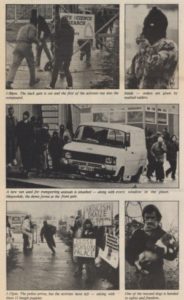Exactly 33 years ago today one of the most famous raids in ALF history took place at Life Science Research (LSR) in Essex. Over 100 activists forced their way into the contract-testing laboratory in broad daylight, rescuing nine beagles and a large number of rats and mice.
The BUAV’s newspaper Liberator said: “Damage estimated at £100,000 plus the almost total destruction of a van used to collect animals for vivisection was the score tallied by the Animal Liberation Front as a result of Operation Valentine.” People fled in cars with the police in pursuit and there were 64 arrests but, importantly, none of the animals were recovered.
Liberator reported a spokesperson for LSR as saying the rescuers were “Nazi-style thugs in uniforms”, before adding: “There is no way our tests are cruel to animals. The ALF’s response was that “the speaker himself must have been a Nazi.”
In context: The LSR raid was the culmination of a series of attacks against the vivisection industry going back to the formation of the ALF six years earlier. In 1977 over 200 animals were liberated from laboratories. In one raid activists broke into Condiltox in North London, causing £80,000 damage. Shortly afterwards the lab closed down.
In August 1979 arson was employed for the first time with a blaze at the Essex offices of lab supplier Tuck and Sons causing £20,000 damage. In 1980 there were about half a dozen raids against vivisection targets including the first attack on a vivisector’s home.
1981 saw a night of action with as many as 40 attacks, mainly with paint, on the houses and cars of vivisectors. A further 18 actions against vivisection targets took place by the end of the year, including a raid on Wickham Laboratories which freed 11 beagles.
According to the book Against All Odds (1986): “There was a further increase in anti-vivisection raids in 1982 and in many ways the year was a landmark for animal liberation action.” In February the first daylight ALF raid at Safepharm Labs in Derbyshire acted as a curtain raiser for Operation Valentine. Film of people fleeing with rabbits was shown on TV and unfortunately this led to eight arrests and suspended sentences for those involved.
What happened next: The raid had an immediate effect on the movement and LSR itself. It received unprecedented publicity including TV and radio coverage and the front page of the Daily Mirror with the headline, “Rescued: hooded raiders free lab dogs” alongside an iconic photo of a masked activist holding a beagle. As well as damage on the day, a £30,000 order was lost as a result of the action and 100 workers were made redundant.
In March 1982 15 guinea pigs were liberated from an animal breeders in Sussex and the following month the ALF raided a supplier of mice, damaging a car and rescuing several dozen inmates. In April the Western Animal Liberation League rescued a beagle at a protest against a lab supplier and the same month the house of a vivisector in Sheffield was daubed with slogans.
Actions continued during the year, including 12 beagles taken from Boots’ lab near Nottingham and Leicester University Psychology Dept’s animal house closed down. World Lab Animal Day in April saw hundreds of people tear down the fence at Porton Down and £2,000 damage was caused to the fence and alarm system at Huntingdon Research Centre during a demo in August.
An Operation Valentine Defence Campaign was set up for the 29 activists who were charged with conspiracy to cause criminal damage and steal. 17 were convicted in 1983, eight of whom were imprisoned for between 21 days and 15 months and a further nine were fined or ordered to do community service. The sentences were harsh for the time but they did not stem the tide of direct action. The rest of the 1980s would be an era of animal rights militancy.
Life Science Research never recovered from the raid and later in the decade it merged with Huntingdon Research Centre to become Huntingdon Life Sciences. The rest, as they say, is history.
